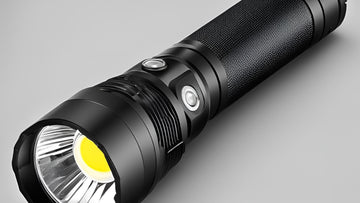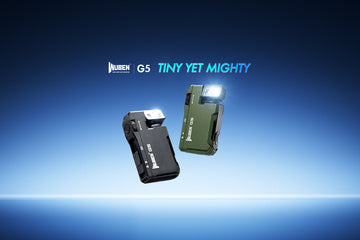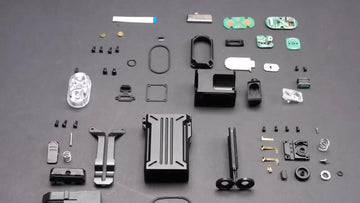
Ever been overwhelmed by the technical jargon on flashlight packaging? Understanding flashlight specifications can make all the difference in finding the perfect light for your needs.
Whether you're a camper, hiker, or just someone who needs a reliable flashlight for emergencies, knowing what to look for can save you time and money. This guide aims to demystify the common specifications you'll encounter, helping you make informed decisions when selecting a flashlight.
Key Specifications to Understand
1. Lumen Output
What it Measures:
Lumens measure the total light output of a flashlight. It's a straightforward way to understand how bright a flashlight can get.
Why it Matters:
The higher the lumens, the brighter the light. This is crucial for activities that require maximum visibility. For instance, a flashlight with 1000 lumens will be significantly brighter than one with 100 lumens.
Comparison:
To give you a sense of scale, a standard 60-watt incandescent bulb produces about 800 lumens. So, if a flashlight is rated at 800 lumens, it’s as bright as that household bulb.
2. Beam Distance
Definition:
Beam distance is the maximum distance at which the flashlight can illuminate an area effectively.
Usage Scenarios:
This specification is vital for activities like hiking or search and rescue, where seeing far ahead can prevent accidents and help in navigation. For example, a flashlight with a beam distance of 200 meters is ideal for night hiking.
3. Candela
What it Measures:
Candela measures the beam intensity at its brightest point.
Importance:
While lumens tell you how much light is emitted, candela indicates how focused that light is. A higher candela rating means the light is more focused in a specific area, which is important for tactical uses or pinpointing objects in the dark.
4. Run Time
Definition:
Run time is the duration a flashlight can operate before the battery needs recharging or replacement.
Considerations:
Run time varies with brightness settings and battery type. A flashlight on its lowest setting will last much longer than on its highest. For example, a flashlight might run for 10 hours on low but only 2 hours on high.
5. Battery Type and Life
Types of Batteries:
Flashlights use either rechargeable or disposable batteries. Rechargeable batteries are more cost-effective and eco-friendly in the long run, while disposable batteries are convenient for immediate use without needing a power source.
Impact on Performance:
The type of battery affects the flashlight's weight, cost, and environmental impact. Rechargeable batteries are typically heavier but reduce long-term costs and waste. Disposable batteries, on the other hand, are lighter and often preferred for emergency kits due to their long shelf life.
6. Water Resistance (IP Rating)
IP Rating System:
The Ingress Protection (IP) rating system indicates the level of protection against dust and water. For example, an IPX4 rating means the flashlight is splash-resistant from any direction, while an IPX8 rating indicates it can be submerged in water beyond one meter.
Scenarios:
Water resistance is crucial for activities like camping, boating, or any situation where the flashlight might get wet. An IPX8-rated flashlight is suitable for boating and water-related activities.
7. Durability
Material and Build Quality:
Flashlights made from materials like aluminum or stainless steel offer better durability. Features like anodized finishes help resist corrosion and wear.
Drop Test Ratings:
Drop test ratings indicate how well a flashlight can withstand impacts. Higher ratings mean the flashlight is more likely to survive rough handling. For instance, a flashlight with a 1-meter drop rating can survive falls from about 3.3 feet without damage.
8. Modes and Features
Light Modes:
Common modes include high, low, and strobe. High mode is for maximum brightness, low for conserving battery, and strobe for emergency signaling. Some flashlights also have medium, SOS, and beacon modes.
Additional Features:
Features like zoom allow you to focus the beam, and SOS signals can be lifesaving in emergencies. Memory functions that remember your last setting can be convenient, so you don’t have to cycle through modes every time you turn on the flashlight.
Practical Tips for Choosing the Right Flashlight
1. Assess Your Needs
User Scenarios:
Select a flashlight based on specific activities. For instance, a compact, high-lumen flashlight is ideal for camping, while a heavy-duty, long-beam flashlight suits home security.
Prioritizing Specifications:
If you need a flashlight for camping, prioritize battery life and water resistance. For tactical use, focus on lumen output and durability. Tailoring your choice to your primary use case ensures you get the most out of your flashlight.
2. Read Reviews and Recommendations
Where to Look:
Check reputable sources like outdoor gear websites, expert reviews, and user feedback on retail sites.
What to Consider:
Pay attention to performance, durability, and user satisfaction. Reviews often highlight practical experiences that specifications alone can't convey. For example, a flashlight might have high lumens but poor build quality, which users will point out in reviews.
3. Testing and Hands-On Experience
In-Store Testing:
Whenever possible, test flashlights in stores to get a feel for their weight, brightness, and build quality.
Return Policies:
When purchasing online, check the return policy to ensure you can return the flashlight if it doesn't meet your expectations. This gives you the flexibility to try out different models without committing to a potentially unsuitable choice.
By understanding specifications like lumen output, beam distance, and battery type, you can confidently choose a flashlight that meets your needs.
Ready to pick the perfect flashlight? Keep these specs in mind and make an informed choice that lights up your world.
Additional Resources
Glossary of Terms:
- Lumens: A measure of total light output.
- Beam Distance: Maximum distance the light can reach.
- Candela: Measure of beam intensity.
- Run Time: Duration the flashlight operates on one set of batteries.
- IP Rating: Ingress Protection rating for water and dust resistance.
Links to Detailed Guides:
By following these guidelines, you'll be well-equipped to navigate the flashlight market and select the best tool for your illumination needs.




